Biermann Ch. Handbook of Pulping and Papermaking
Подождите немного. Документ загружается.

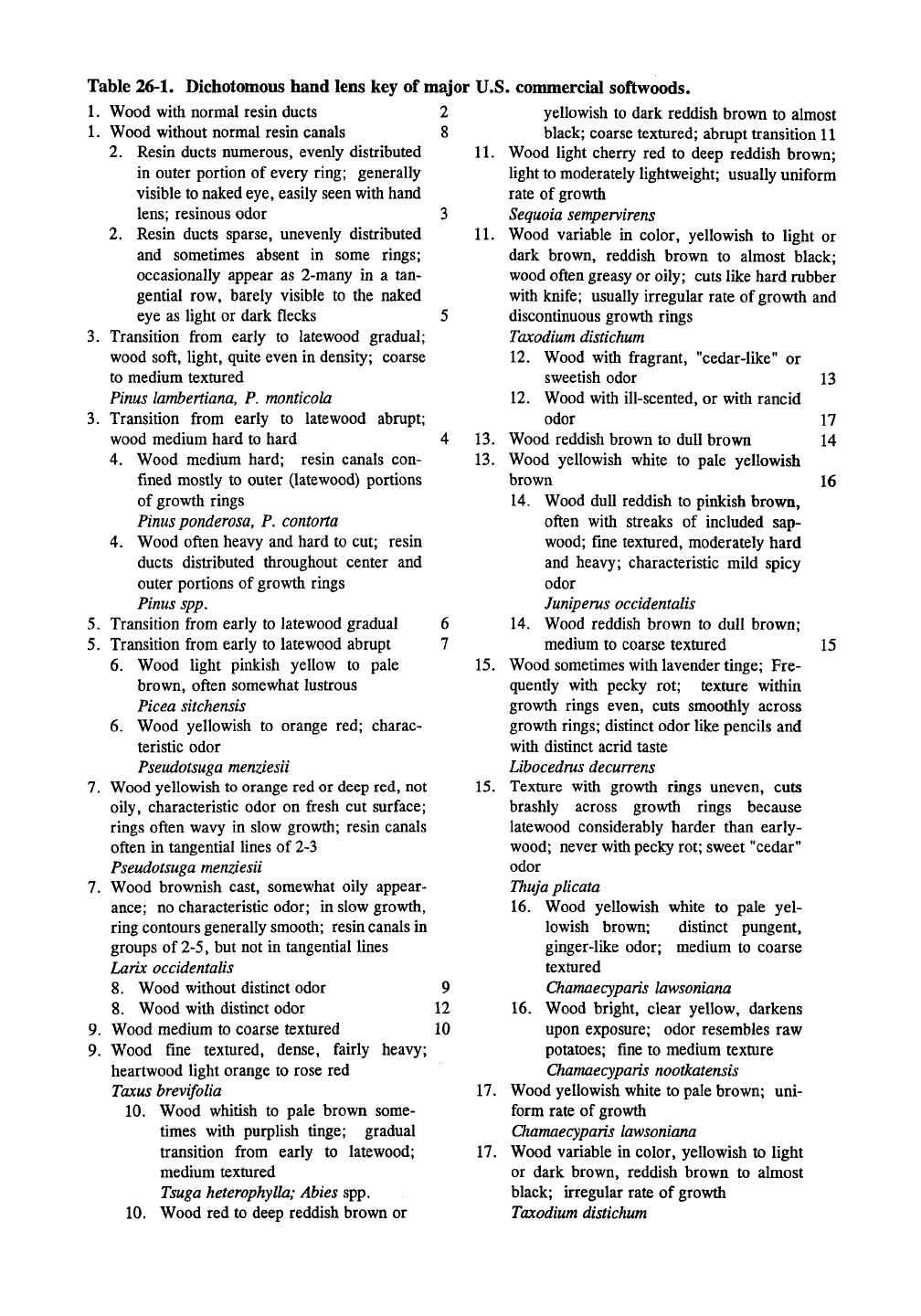
Table 26-1. Dichotomous hand lens key of major
1.
Wood with normal resin ducts 2
1.
Wood without normal resin canals 8
2.
Resin ducts numerous, evenly distributed
in outer portion of every ring; generally
visible to naked
eye,
easily seen with hand
lens;
resinous odor 3
2.
Resin ducts sparse, unevenly distributed
and sometimes absent in some rings;
occasionally appear as 2-many in a tan-
gential row, barely visible to the naked
eye as light or dark flecks 5
3.
Transition from early to late wood gradual;
wood soft, light, quite even in density; coarse
to medium textured
Pinus
lambertiana,
P.
monticola
3.
Transition from early to late wood abrupt;
wood medium hard to hard 4
4.
Wood medium hard; resin canals con-
fined mostly to outer (latewood) portions
of growth rings
Pinus
ponderosa,
P.
contorta
4.
Wood often heavy and hard to cut; resin
ducts distributed throughout center and
outer portions of growth rings
Pinus
spp.
5.
Transition from early to latewood gradual 6
5.
Transition from early to latewood abrupt 7
6. Wood light pinkish yellow to pale
brown, often somewhat lustrous
Picea sitchensis
6. Wood yellowish to orange red; charac-
teristic odor
Pseudotsuga menziesii
7.
Wood yellowish to orange red or deep red, not
oily, characteristic odor on fresh cut surface;
rings often wavy in slow growth; resin canals
often in tangential lines of 2-3
Pseudotsuga menziesii
7.
Wood brownish cast, somewhat oily appear-
ance;
no characteristic odor; in slow growth,
ring contours generally smooth; resin canals in
groups of
2-5,
but not in tangential lines
Larix
occidentalis
8. Wood without distinct odor 9
8. Wood with distinct odor 12
9. Wood medium to coarse textured 10
9. Wood fine textured, dense, fairly heavy;
heartwood light orange to rose red
Tcaus brevifolia
10.
Wood whitish to pale brown some-
times with purplish tinge; gradual
transition from early to latewood;
medium textured
Tsuga
heterophylla;
Abies
spp.
10.
Wood red to deep reddish brown or
U.S. conunercial softwoods.
yellowish to dark reddish brown to almost
black; coarse textured; abrupt transition 11
11.
Wood light cherry red to deep reddish brown;
light
to
moderately lightweight; usually uniform
rate of growth
Sequoia sempervirens
11.
Wood variable in color, yellowish to light or
dark brown, reddish brown to almost black;
wood often greasy or oily; cuts like hard rubber
with knife; usually irregular rate of growth and
discontinuous growth rings
Taxodium distichum
12.
Wood with fragrant, "cedar-like" or
sweetish odor 13
12.
Wood with ill-scented, or with rancid
odor 17
13.
Wood reddish brown to dull brown 14
13.
Wood yellowish white to pale yellowish
brown 16
14.
Wood dull reddish to pinkish brown,
often with streaks of included sap-
wood; fine textured, moderately hard
and heavy; characteristic mild spicy
odor
Juniperus occidentalis
14.
Wood reddish brown to dull brown;
medium to coarse textured 15
15.
Wood sometimes with lavender
tinge;
Fre-
quently with pecky rot; texture within
growth rings even, cuts smoothly across
growth rings; distinct odor like pencils and
with distinct acrid taste
Libocedrus decurrens
15.
Texture with growth rings uneven, cuts
brashly across growth rings because
latewood considerably harder than early-
wood; never with pecky rot; sweet "cedar"
odor
Thuja plicata
16.
Wood yellowish white to pale yel-
lowish brown; distinct pungent,
ginger-like odor; medium to coarse
textured
Chamaecyparis lawsoniana
16.
Wood bright, clear yellow, darkens
upon exposure; odor resembles raw
potatoes; fine to medium texture
Chamaecyparis nootkatensis
17.
Wood yellowish white to pale brown; uni-
form rate of growth
Chamaecyparis lawsoniana
17.
Wood variable in color, yellowish to light
or dark brown, reddish brown to almost
black; irregular rate of growth
Taxodium distichum
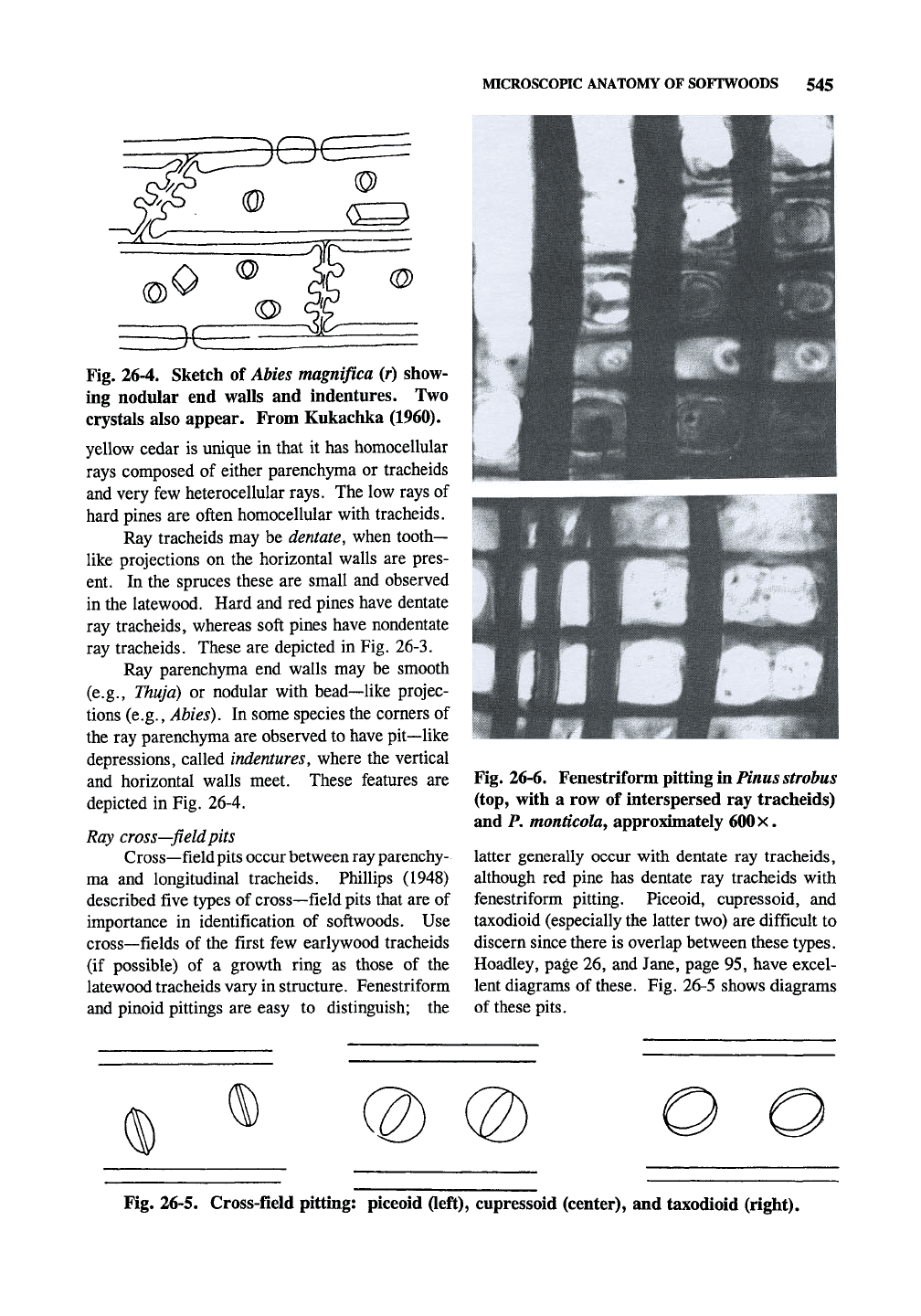
MICROSCOPIC ANATOMY OF SOFTWOODS 545
Fig. 26-4. Sketch of Abies magnifica (r) show-
ing nodular end walls and indentures. Two
crystals also appear. From Kukachka (1960).
yellow cedar is unique in that it has homocellular
rays composed of either parenchyma or tracheids
and very few heterocellular rays. The low rays of
hard pines are often homocellular with tracheids.
Ray tracheids may be dentate, when tooth-
like projections on the horizontal walls are pres-
ent. In the spruces these are small and observed
in the latewood. Hard and red pines have dentate
ray tracheids, whereas soft pines have nondentate
ray tracheids. These are depicted in Fig. 26-3.
Ray parenchyma end walls may be smooth
(e.g., Thuja) or nodular with bead—like projec-
tions (e.g., Abies), In some species the corners of
the ray parenchyma are observed to have pit—like
depressions, called indentures, where the vertical
and horizontal walls meet. These features are
depicted in Fig. 26-4.
Ray cross—field pits
Cross—field pits occur between ray parenchy-
ma and longitudinal tracheids. Phillips (1948)
described five types of cross—field pits that are of
importance in identification of softwoods. Use
cross—fields of the first few earlywood tracheids
(if possible) of a growth ring as those of the
latewood tracheids vary in structure. Fenestriform
and pinoid pittings are easy to distinguish; the
Fig. 26-6. YtnesirifOYrxn^iiimginPinusstrobus
(top,
with a row of interspersed ray tracheids)
and P. monticola, approximately
600
X.
latter generally occur with dentate ray tracheids,
although red pine has dentate ray tracheids with
fenestriform pitting. Piceoid, cupressoid, and
taxodioid (especially the latter two) are difficult to
discern since there is overlap between these types.
Hoadley, page 26, and Jane, page 95, have excel-
lent diagrams of
these.
Fig. 26-5 shows diagrams
of these pits.
Fig. 26-5. Cross-field pitting: piceoid (left), cupressoid (center), and taxodioid (right).

546 26. SOFTWOOD ANATOMY
Fenestriform pits are large, borderless rectan-
gular "window—like" pits with usually 1—2 pits
per cross—field (Fig. 26-6). Most other types
have 2 to 6 pits per cross—field. These distinctive
pits are characteristic of the soft (white, scotch,
etc.) and red pines. Sugar pine has 2—4
fenestriform pits per cross—field.
Pinoid are elliptical to irregular polygons in
shape (Fig. 26-7). They vary in size. The bor-
ders may or may not be visible around the aper-
tures.
When they are visible they are narrow and
usually wider on one side than the other. These
are characteristic of the hard pines (except red
pine) and occur in species with dentate ray
tracheids.
Piceoid have slit—like apertures that may
extend beyond the visible border (Fig. 26-8). The
width of the aperture is less than that of the
aperture to the border. They occur in spruce,
larch, and Douglas—fir.
Cupressoid are similar to piceoid, but the
apertures are contained within the boundaries of
the border and their width is slightly less than that
Fig. 26-7. Pinoid pitting in Pinus banksiana
(top,
with shallowly dentate ray tracheid) and
P. ponderosa (prominently dentate ray
tracheids), approximately 600x.
Fig. 26-8. Piceoid pitting in Picea sitchensis
(top,
note nodular end wall), Larix
occidentalism
and Pseudotsuga menziesii (note indentures),
approximately 600 x.
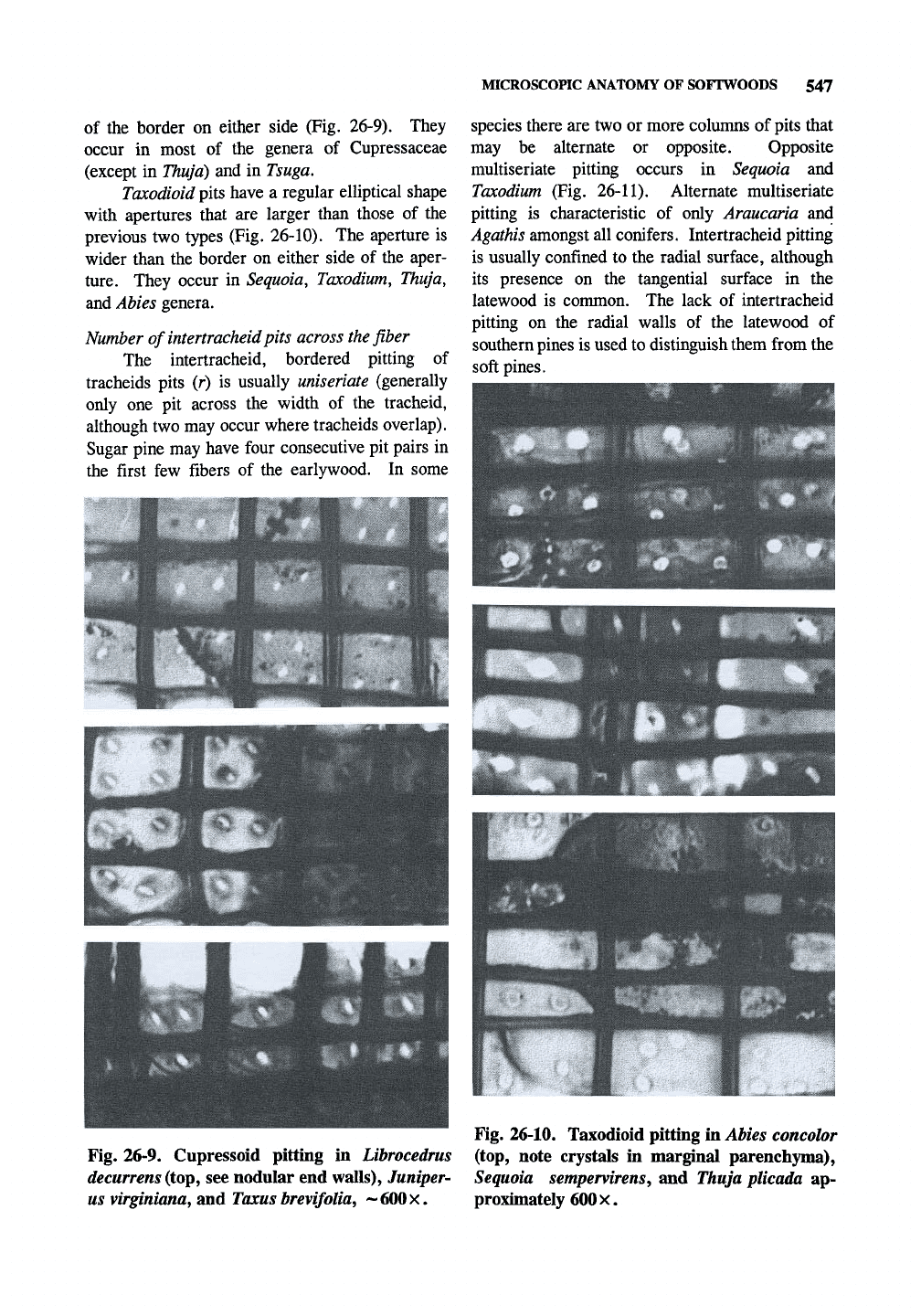
MICROSCOPIC ANATOMY OF SOFTWOODS 547
of the border on either side (Fig. 26-9). They
occur in most of the genera of Cupressaceae
(except in Thuja) and in Tsuga.
Taxodioid pits have a regular elHptical shape
with apertures that are larger than those of the
previous two types (Fig. 26-10). The aperture is
wider than the border on either side of the aper-
ture.
They occur in Sequoia, Taxodium, Thuja,
and Abies genera.
Number of intertracheid pits across
the
fiber
The intertracheid, bordered pitting of
tracheids pits (r) is usually uniseriate (generally
only one pit across the width of the tracheid,
although two may occur where tracheids overlap).
Sugar pine may have four consecutive pit pairs in
the first few fibers of the earlywood. In some
Pip g^;
species there are two or more columns of
pits
that
may be alternate or opposite. Opposite
multiseriate pitting occurs in Sequoia and
Taxodium (Fig. 26-11). Alternate multiseriate
pitting is characteristic of only Araucaria and
Agathis amongst all conifers. Intertracheid pitting
is usually confined to the radial surface, although
its presence on the tangential surface in the
latewood is common. The lack of intertracheid
pitting on the radial walls of the latewood of
southern
pines
is used to distinguish them from the
soft pines.
Fig. 26-9. Cupressoid pitting in Lihrocedrus
decurrens
(to^^
see nodular end walls), Juniper-
us
virginiana^
and
Taxus
brevifolia^
-600x.
Fig. 26-10. Taxodioid pitting in Abies concolor
(top,
note crystals in marginal parenchyma),
Sequoia
sempervirens^
and Thuja plicada ap-
proximately
600
X.
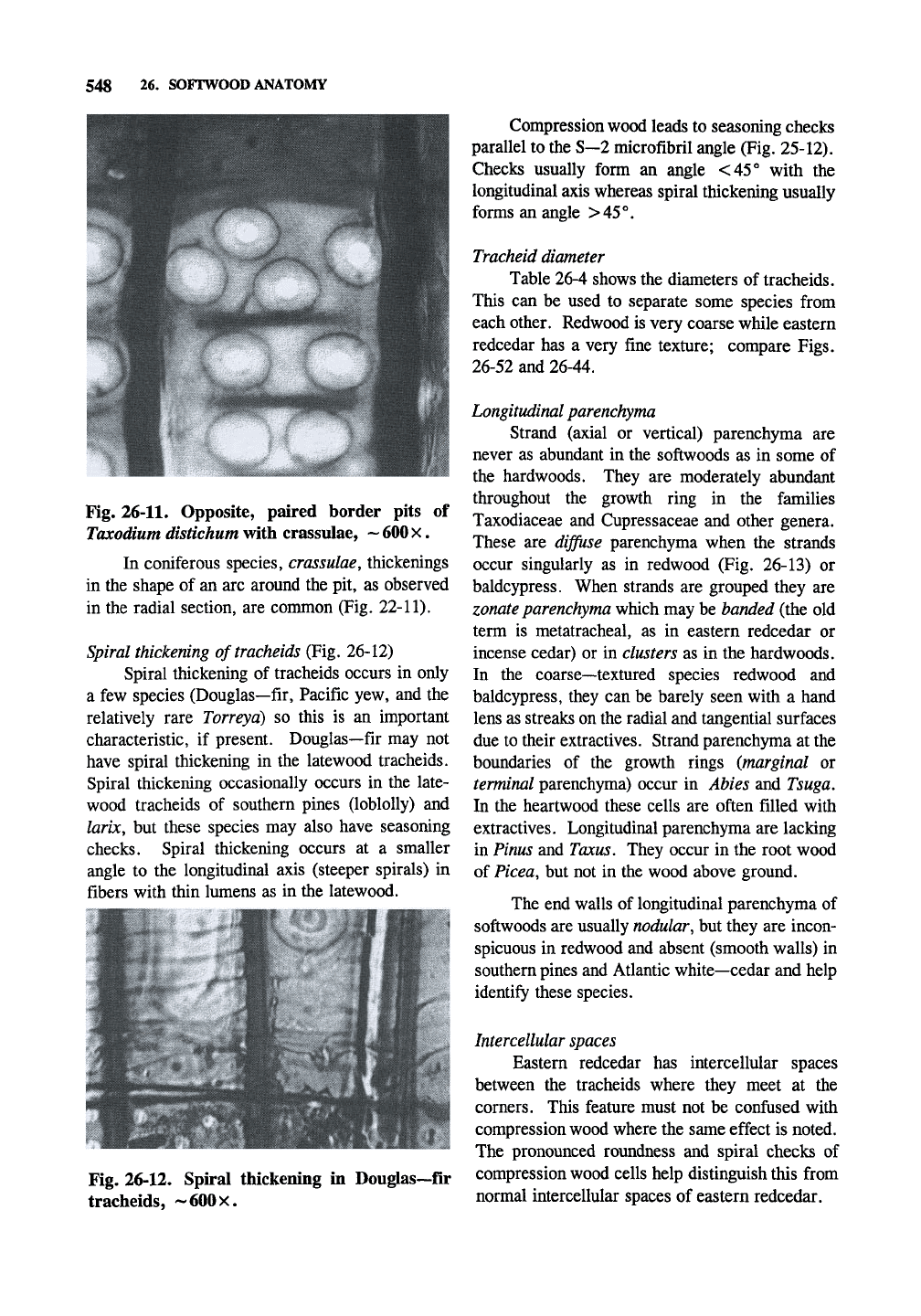
548 26. SOFTWOOD ANATOMY
Fig.
26-11.
Opposite, paired border pits of
Taxodium distichum with crassulae,
-- 600
x.
In coniferous species, crassulae, thickenings
in the shape of an arc around the pit, as observed
in the radial section, are common (Fig. 22-11).
Spiral thickening oftracheids (Fig. 26-12)
Spiral thickening of tracheids occurs in only
a few species (Douglas—fir, Pacific yew, and the
relatively rare Torreya) so this is an important
characteristic, if present. Douglas—fir may not
have spiral thickening in the latewood tracheids.
Spiral thickening occasionally occurs in the late-
wood tracheids of southern pines (loblolly) and
larix, but these species may also have seasoning
checks. Spiral thickening occurs at a smaller
angle to the longitudinal axis (steeper spirals) in
fibers with thin lumens as in the latewood.
Fig. 26-12. Spiral thickening in Douglas—fir
tracheids, '-'600X.
Compression wood leads to seasoning checks
parallel to the S—2 microfibril angle (Fig. 25-12).
Checks usually form an angle <45° with the
longitudinal axis whereas spiral thickening usually
forms an angle >45°.
Tracheid diameter
Table 26-4 shows the diameters oftracheids.
This can be used to separate some species from
each other. Redwood is very coarse while eastern
redcedar has a very fine texture; compare Figs.
26-52 and 26-44.
Longitudinal parenchyma
Strand (axial or vertical) parenchyma are
never as abundant in the softwoods as in some of
the hardwoods. They are moderately abundant
throughout the growth ring in the families
Taxodiaceae and Cupressaceae and other genera.
These are dijfuse parenchyma when the strands
occur singularly as in redwood (Fig. 26-13) or
baldcypress. When strands are grouped they are
zonate parenchyma which may be banded (the old
term is metatracheal, as in eastern redcedar or
incense cedar) or in clusters as in the hardwoods.
In the coarse—textured species redwood and
baldcypress, they can be barely seen with a hand
lens as streaks on the radial and tangential surfaces
due to their extractives. Strand parenchyma at the
boundaries of the growth rings {marginal or
terminal parenchyma) occur in Abies and Tsuga.
In the heartwood these cells are often filled with
extractives. Longitudinal parenchyma are lacking
in Pinus and Taxus. They occur in the root wood
of Picea, but not in the wood above ground.
The end walls of longitudinal parenchyma of
softwoods are usually nodular, but they are incon-
spicuous in redwood and absent (smooth walls) in
southern pines and Atlantic white—cedar and help
identify these species.
Intercellular spaces
Eastern redcedar has intercellular spaces
between the tracheids where they meet at the
corners. This feature must not be confiised with
compression wood where the same effect is noted.
The pronounced roundness and spiral checks of
compression wood cells help distinguish this from
normal intercellular spaces of eastern redcedar.
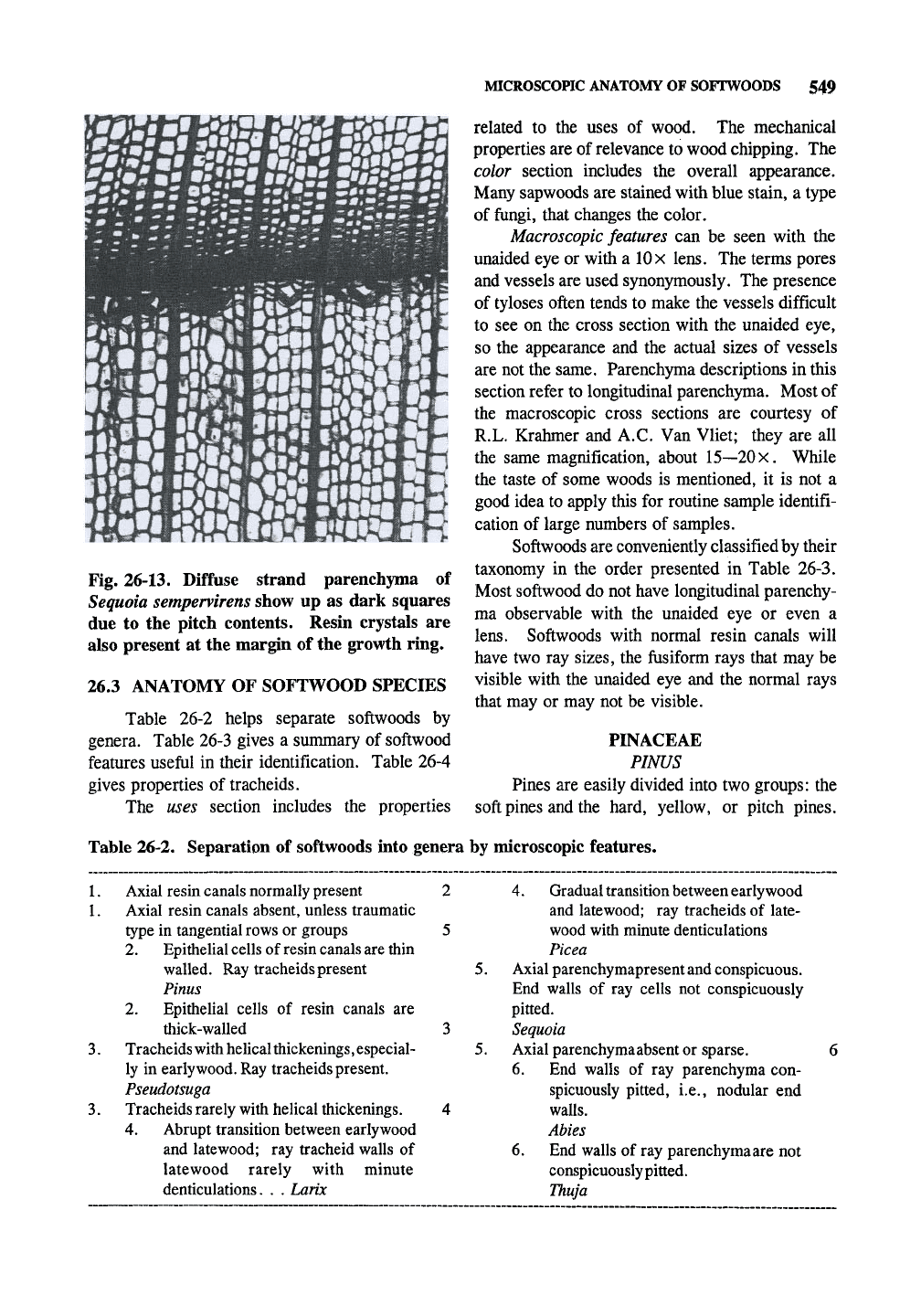
Fig. 26-13. Diffuse strand parenchyma of
Sequoia sempervirens show up as dark squares
due to the pitch contents. Resin crystals are
also present at the margin of the growth ring.
26.3 ANATOMY OF SOFTWOOD SPECIES
Table 26-2 helps separate softwoods by
genera. Table 26-3 gives a summary of softwood
features useful in their identification. Table 26-4
gives properties of tracheids.
The uses section includes the properties
MICROSCOPIC ANATOMY OF SOFTWOODS 549
related to the uses of wood. The mechanical
properties are of relevance to wood chipping. The
color section includes the overall appearance.
Many sapwoods are stained with blue stain, a type
of fimgi, that changes the color.
Macroscopic features can be seen with the
unaided eye or with a lOx lens. The terms pores
and vessels are used synonymously. The presence
of tyloses often tends to make the vessels difficult
to see on the cross section with the unaided eye,
so the appearance and the actual sizes of vessels
are not the same. Parenchyma descriptions in this
section refer to longitudinal parenchyma. Most of
the macroscopic cross sections are courtesy of
R.L. Krahmer and A.C. Van Vliet; they are all
the same magnification, about 15~20x. While
the taste of some woods is mentioned, it is not a
good idea to apply this for routine sample identifi-
cation of large numbers of samples.
Softwoods are conveniently classified by their
taxonomy in the order presented in Table 26-3.
Most softwood do not have longitudinal parenchy-
ma observable with the unaided eye or even a
lens.
Softwoods with normal resin canals will
have two ray sizes, the fusiform rays that may be
visible with the unaided eye and the normal rays
that may or may not be visible.
PINACEAE
PINUS
Pines are easily divided into two groups: the
soft pines and the hard, yellow, or pitch pines.
Table 26-2. Separation of softwoods into genera by microscopic features.
1.
Axial resin canals normally present
1.
Axial resin canals absent, unless traumatic
type in tangential
rows
or groups
2.
Epithelial
cells
of
resin canals are
thin
walled. Ray
tracheids
present
Pinus
2.
Epithelial cells of resin canals are
thick-walled
3.
Tracheids
with
helical thickenings, especial-
ly in early
wood.
Ray tracheids present.
Pseudotsuga
3.
Tracheids rarely with helical thickenings.
4.
Abrupt transition between early wood
and late wood; ray tracheid walls of
late wood rarely with minute
denticulations. . . Larix
4.
Gradual
transition between early wood
and late wood; ray tracheids of late-
wood with minute denticulations
Picea
5.
Axial parenchymapresent
and
conspicuous.
End walls of ray cells not conspicuously
pitted.
Sequoia
5.
Axial parenchyma absent or sparse.
6. End walls of ray parenchyma con-
spicuously pitted, i.e., nodular end
walls.
Abies
6. End walls of ray parenchyma are not
conspicuously pitted.
Thuja
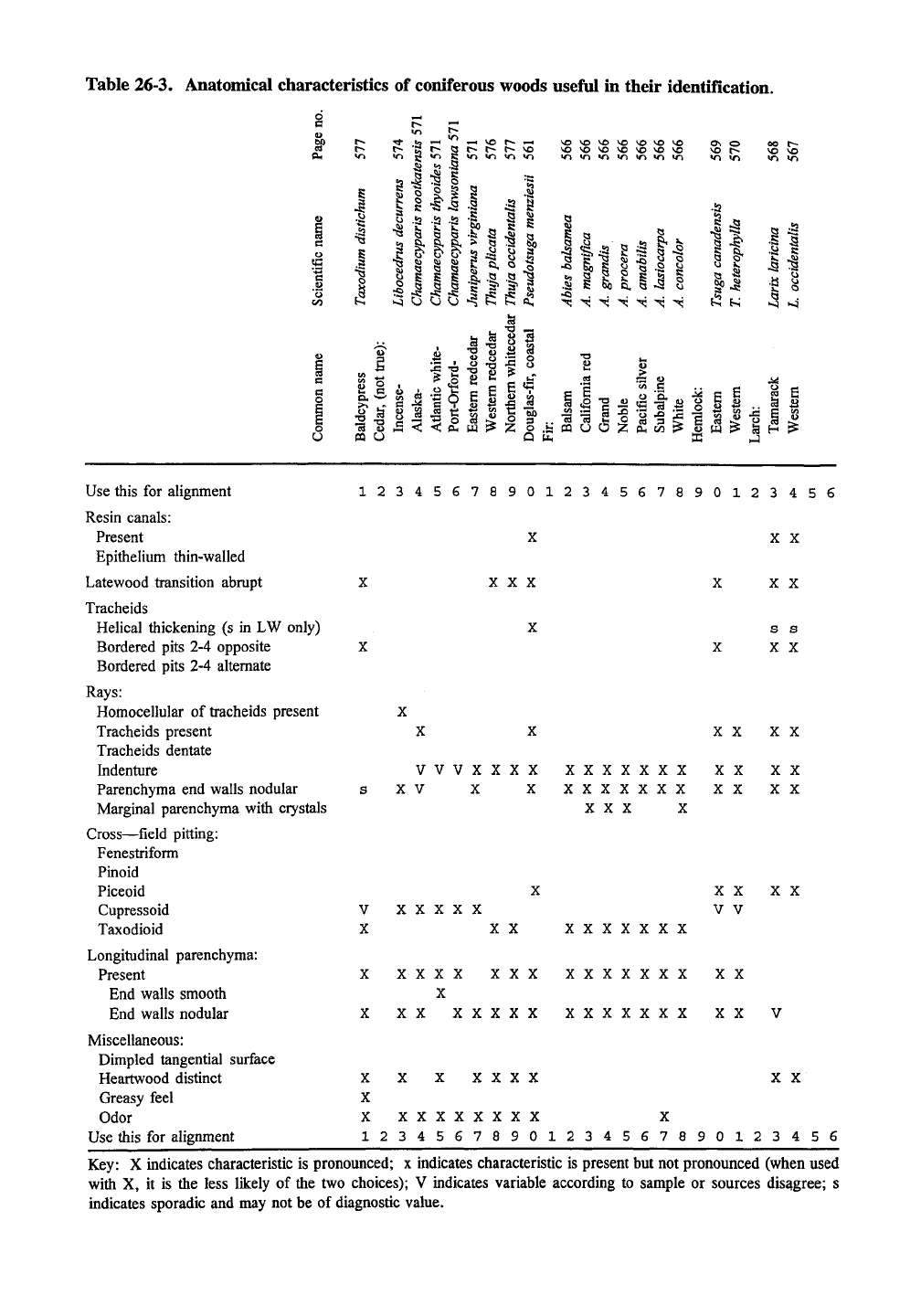
Table 26-3. Anatomical characteristics of coniferous woods useful in their identification.
w
1
u
i
I
I
I
.tn
'-^ ^ vo r- ^
K
t^ a r- t^ t^ vo
•a
»n
«r> >n »r>
•^
^ -S
s
s
^
^
g
^ ? ^ §
^
^ b}
O
O O
IS
T3
11
I
s^
5-1
8
e
i
E
«?
§
S?
z
VO
^ vo vo vo vo vo
vo
vo ^ vo vo vo vo
«n
>n m »n «r> »n w^
•Si
S
Q
U^
•a
c
I.
Uil i
'^ "^ "^ "^ "^
'^^
"^
2
&Z
^
.s
S "^
.^
CL,
00 l>
J
Use this
for
alignment
Resin canals:
Present
Epithelium thin-walled
Latewood transition abrupt
Tracheids
Helical thickening
(s in LW
only)
Bordered pits
2-4
opposite
Bordered pits
2-4
alternate
Rays:
Homocellular
of
tracheids present
Tracheids present
Tracheids dentate
Indenture
Parenchyma
end
walls nodular
Marginal parenchyma with crystals
Cross—field pitting:
Fenestriform
Pinoid
Piceoid
Cupressoid
Taxodioid
Longitudinal parenchyma:
Present
End walls smooth
End walls nodular
Miscellaneous:
Dimpled tangential surface
Heartwood distinct
Greasy feel
Odor
Use this
for
alignment
1234567890123
X
X
XXX
V
X
X
X
567890123456
X
X
X
XX
s
s
X
XX
X
X X X X X
VVVXXXX XXXXXXX
XX XX
XV
X X
XXXXXXX
XX XX
XXX
X
X
X X X X
X
X
XXXXXXX
XXXX
XXX
XXXXXXX
X
XX XXXXX XXXXXXX
XX
XX
V
V
X
X
X
X
XXXXXXX
XX
X
X XXXXXXXX
X
12345678901234567890123456
Key:
X
indicates characteristic
is
pronounced;
x
indicates characteristic
is
present but
not
pronounced (when used
with
X, it is the
less likely
of the two
choices);
V
indicates variable according
to
sample
or
sources disagree;
s
indicates sporadic
and may not be of
diagnostic value.
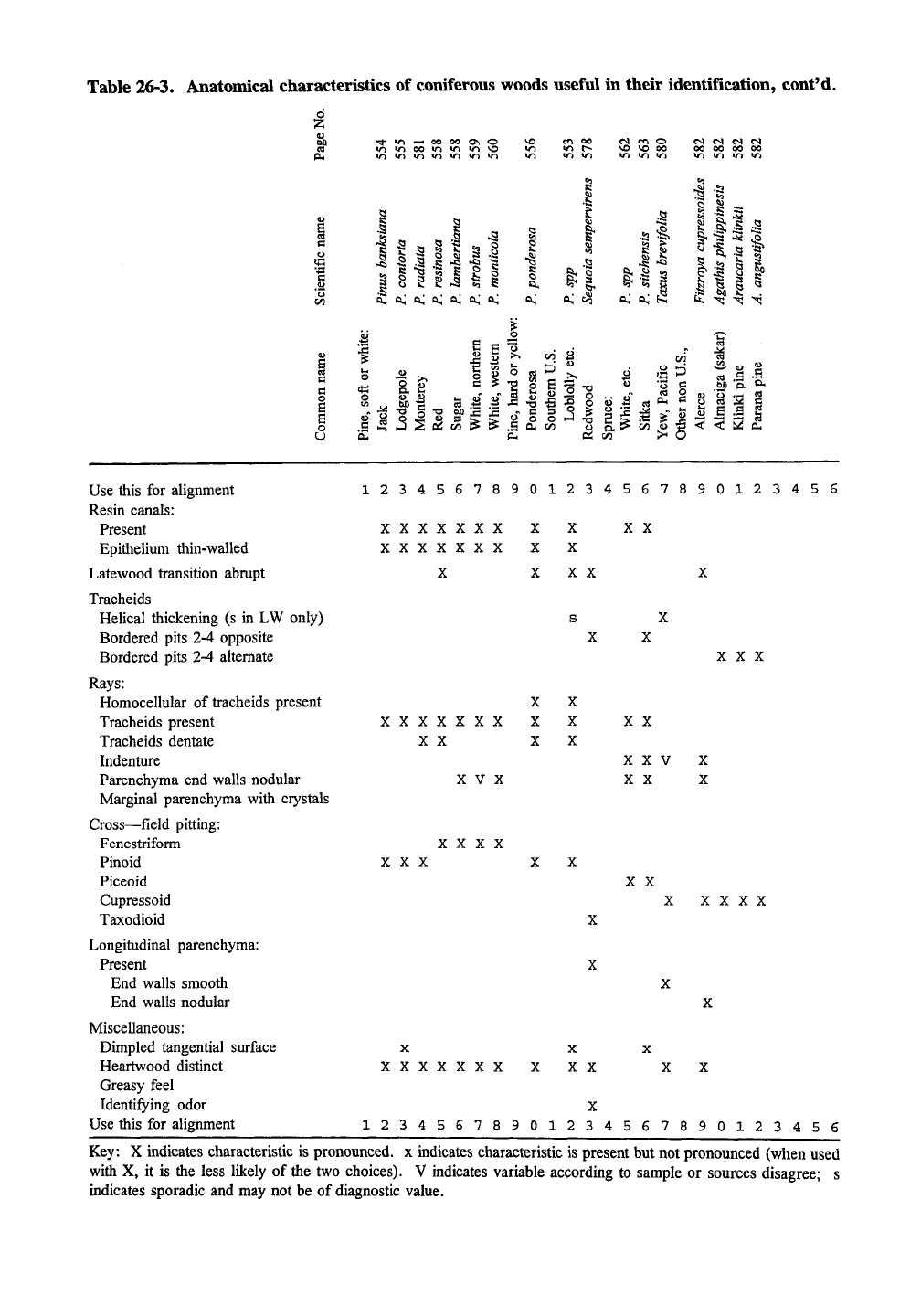
Table 26-3. Anatomical characteristics of coniferous woods useful in their identiHcation, cont'd.
Tf>n-H00ooo\o vo moo <Nmo <srs<NtN
m»noo>n»n«nvo ^n mr-* ^^ovooo oooooooo
a:; a^ a^ a,' a," cx^
Q; a; ft,' c^ a^' o^ E-. tj^ ^ ^ ^
e c ^ . ... . §
o
B
B
o
O
s ^ a I s i a I ^ 11 I 8 i
„
<2
s § I 3 I
X X X X X X X
X X X X X X X
X
X X X X X X X
X X
X V X
X
X
X
X
X
X
X
X
X X
s
X
X
X
X
X
X
X
X
X
X
X
X
X V
X
X
X
X
Use this for alignment 12345678901234567890123456
Resin canals:
Present
Epithelium thin-walled
Latewood transition abrupt
Tracheids
Helical thickening (s in LW only)
Bordered pits 2-4 opposite
Bordered pits 2-4 alternate XXX
Rays:
Homocellular of tracheids present
Tracheids present
Tracheids dentate
Indenture
Parenchyma end walls nodular
Marginal parenchyma with crystals
Cross—field pitting:
Fenestriform X X X X
Pinoid XXX XX
Piceoid X X
Cupressoid X X X X X
Taxodioid X
Longitudinal parenchyma:
Present X
End walls smooth X
End walls nodular X
Miscellaneous:
Dimpled tangential surface x x x
Heartwood distinct XXXXXXX X XX X X
Greasy feel
Identifying odor X
Use this for alignment 12345678901234567890123456
Key: X indicates characteristic is pronounced, x mdicates characteristic is present but not pronounced (when used
with X, it is the less likely of the two choices). V indicates variable according to sample or sources disagree; s
indicates sporadic and may not be of diagnostic value.
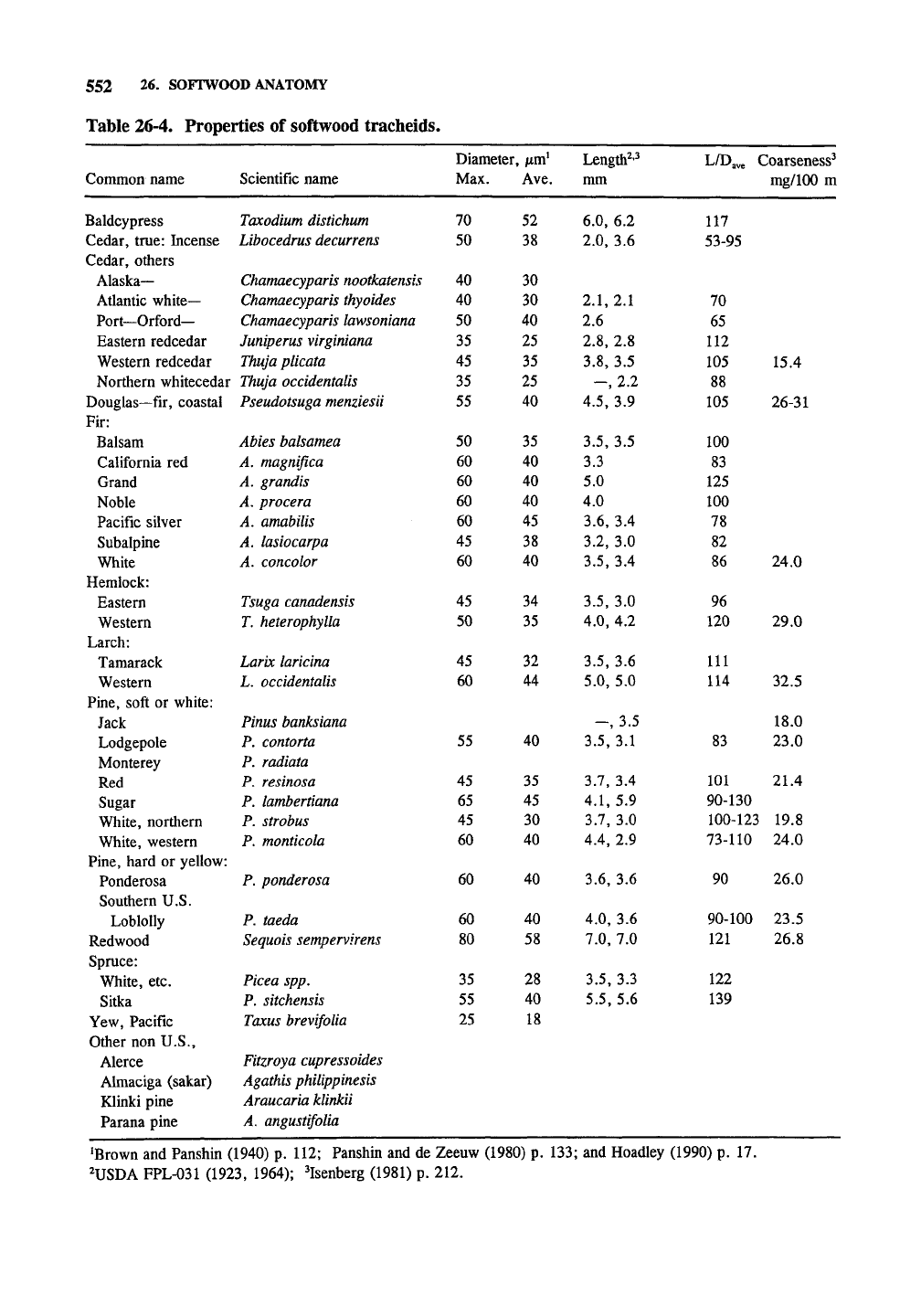
552
26.
SOFTWOOD ANATOMY
Table 26-4. Properties of softwood tracheids.
Common name
Baldcypress
Cedar, true: Incense
Cedar, others
Alaska-
Atlantic white-
Port—Orford—
Eastern redcedar
Western redcedar
Northern whitecedar
Douglas—fir, coastal
Fir:
Balsam
California red
Grand
Noble
Pacific silver
Subalpine
White
Hemlock:
Eastern
Western
Larch:
Tamarack
Western
Pine, soft or white:
Jack
Lodgepole
Monterey
Red
Sugar
White, northern
White, western
Pine, hard or yellow:
Ponderosa
Southern U.S.
Loblolly
Redwood
Spruce:
White, etc.
Sitka
Yew, Pacific
Other non U.S.,
Alerce
Almaciga (sakar)
Klinki pine
Parana pine
Scientific name
Taxodium distichum
Libocedrus decurrens
Chamaecyparis nootkatensis
Chamaecyparis thyoides
Chamaecyparis lawsoniana
Juniperus virginiana
Thuja
plicata
Thuja occidentalis
Pseudotsuga menziesii
Abies balsamea
A.
magnifica
A.
grandis
A.
procera
A.
amabilis
A.
lasiocarpa
A.
concolor
Tsuga canadensis
T. heterophylla
Larix
laricina
L.
occidentalis
Pinus banksiana
P. contorta
P. radiata
P. resinosa
P. lambertiana
P. strobus
P, monticola
P. ponderosa
P. taeda
Sequois sempervirens
Picea spp.
P. sitchensis
Taxus brevifolia
Fitzroya cupressoides
Agathis philippinesis
Araucaria klinkii
A.
angustifolia
Diametei
Max.
70
50
40
40
50
35
45
35
55
50
60
60
60
60
45
60
45
50
45
60
55
45
65
45
60
60
60
80
35
55
25
',
I^T^^
Ave.
52
38
30
30
40
25
35
25
40
35
40
40
40
45
38
40
34
35
32
44
40
35
45
30
40
40
40
58
28
40
18
Length^'^
mm
6.0, 6.2
2.0, 3.6
2.1,2.1
2.6
2.8, 2.8
3.8,
3.5
-,2.2
4.5, 3.9
3.5,
3.5
3.3
5.0
4.0
3.6, 3.4
3.2,
3.0
3.5,
3.4
3.5,
3.0
4.0, 4.2
3.5,
3.6
5.0, 5.0
-,3.5
3.5,3.1
3.7, 3.4
4.1,5.9
3.7, 3.0
4.4,
2.9
3.6, 3.6
4.0, 3.6
7.0, 7.0
3.5,
3.3
5.5,5.6
L/Dj,ye
Coarseness^
117
53-95
70
65
112
105
88
105
100
83
125
100
78
82
86
96
120
111
114
83
101
90-130
100-123
73-110
90
90-100
121
122
139
mg/100 m
15.4
26-31
24.0
29.0
32.5
18.0
23.0
21.4
19.8
24.0
26.0
23.5
26.8
^Brown and Panshin (1940) p. 112; Panshin and de Zeeuw (1980) p. 133; and Hoadley (1990) p. 17.
^USDA FPL-031 (1923, 1964); ^Isenberg (1981) p. 212.
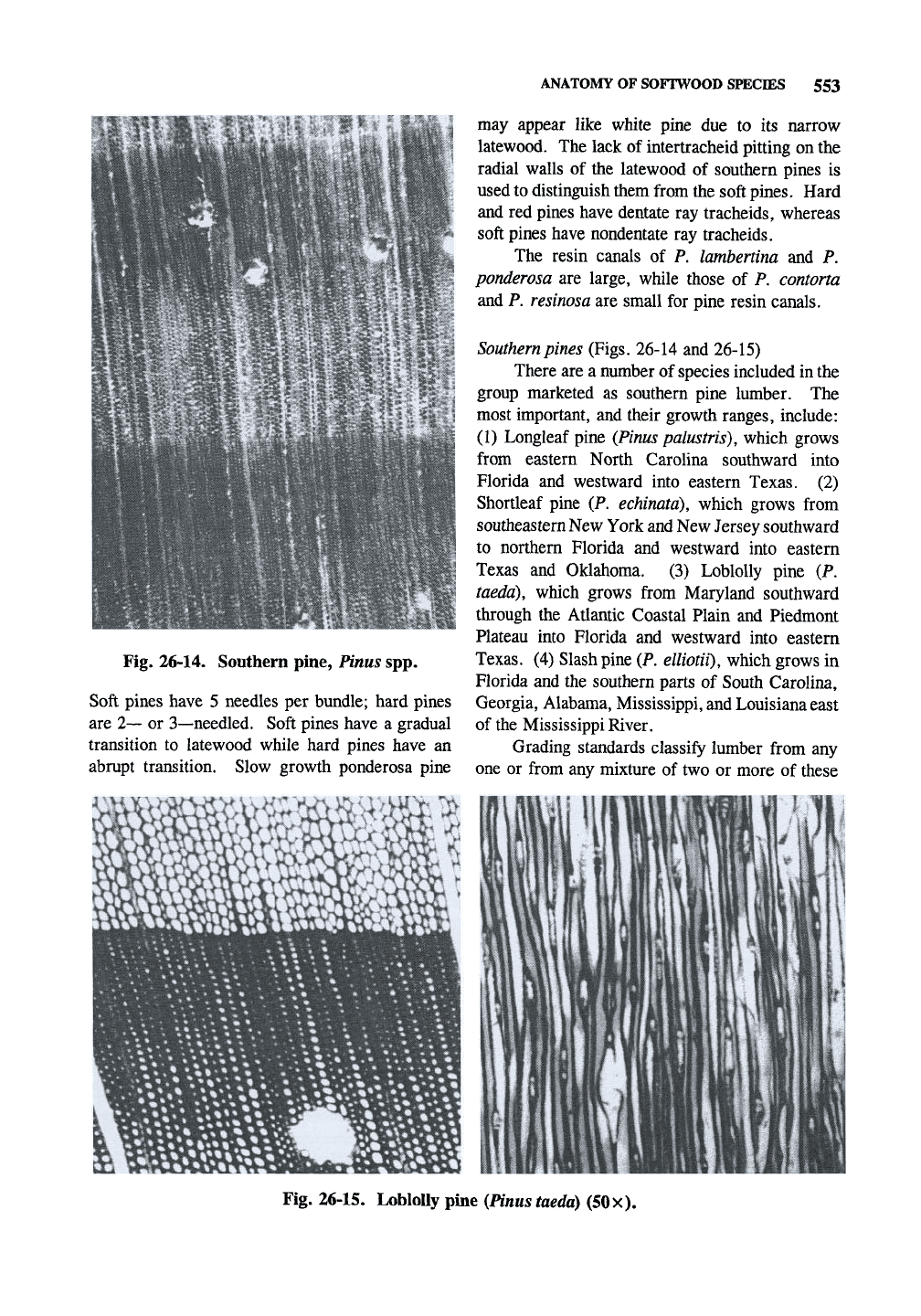
Fig. 26-14. Southern pine, Pinus spp.
Soft pines have 5 needles per bundle; hard pines
are 2— or 3—needled. Soft pines have a gradual
transition to latewood while hard pines have an
abrupt transition. Slow growth ponderosa pine
ANATOMY OF SOFTWOOD SPECIES 553
may appear like white pine due to its narrow
latewood. The lack of intertracheid pitting on the
radial walls of the latewood of southern pines is
used to distinguish them from the soft
pines.
Hard
and red pines have dentate ray tracheids, whereas
soft pines have nondentate ray tracheids.
The resin canals of P. lambertina and P.
ponderosa are large, while those of P. contorta
and P. resinosa are small for pine resin canals.
Southern
pines (Figs. 26-14 and 26-15)
There are a number of species included in the
group marketed as southern pine lumber. The
most important, and their growth ranges, include:
(1) Longleaf pine
{Pinus
palustris), which grows
from eastern North Carolina southward into
Florida and westward into eastern Texas. (2)
Shortleaf pine (P. echinata), which grows from
southeastern New York and New Jersey southward
to northern Florida and westward into eastern
Texas and Oklahoma. (3) Loblolly pine {P.
taeda),
which grows from Maryland southward
through the Atlantic Coastal Plain and Piedmont
Plateau into Florida and westward into eastern
Texas. (4) Slash pine
{P.
elliotii), which grows in
Florida and the southern parts of South Carolina,
Georgia, Alabama, Mississippi, and Louisiana east
of the Mississippi River.
Grading standards classify lumber from any
one or from any mixture of two or more of these
Fig. 26-15. Loblolly pine
(Pinus taeda)
(50x).
